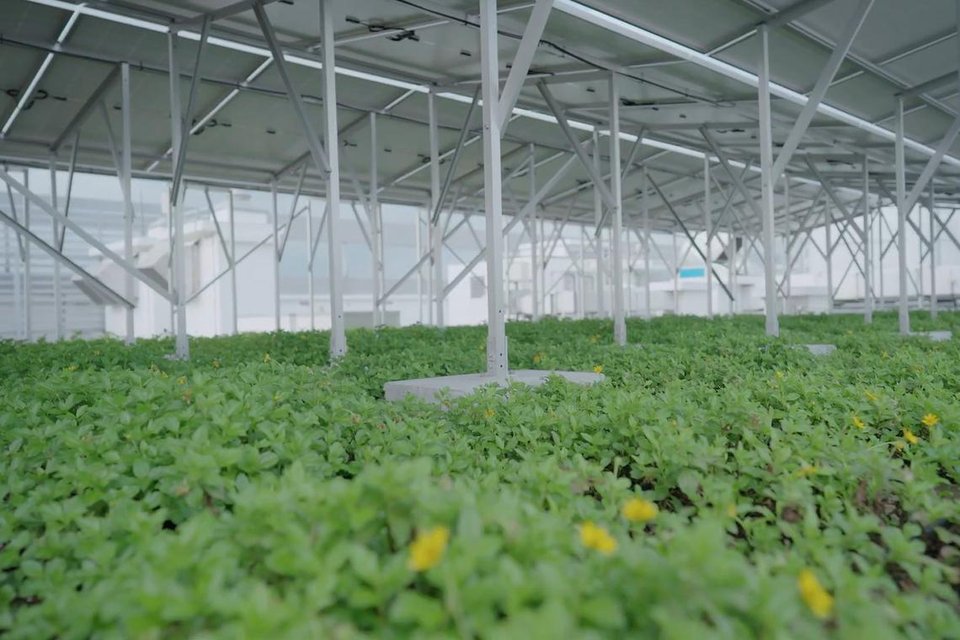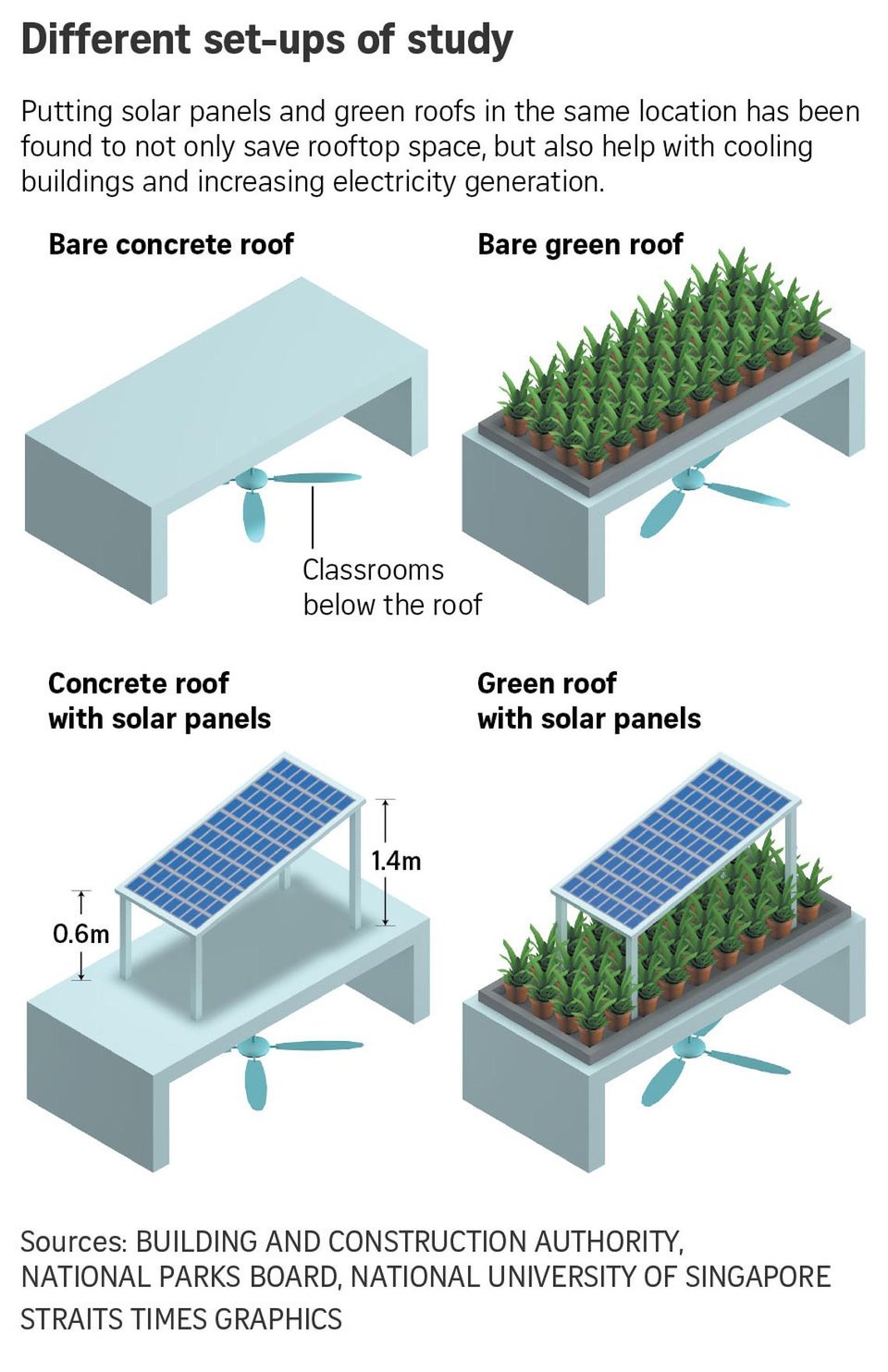Co-locating solar panels and green roofs saves space, increases electricity generation: Study

(Photo credit: Courtesy of NParks)
Source: The Straits Times
A new study in Singapore has found that co-locating solar panels and green roofs not only uses space more efficiently and enhances rooftop greenery, but also boosts electricity generation and cools buildings.
The higher energy output and lower indoor temperatures could, in turn, help building owners cut costs.
The study was done by the Building and Construction Authority (BCA), National Parks Board (NParks) and National University of Singapore (NUS).
The findings challenge the traditional view that solar panels and green roofs are mutually exclusive as both systems need direct sunlight, said researchers of the study.
“The conventional understanding is that if greenery is shaded by solar panels, the greenery will not thrive due to reduced photosynthesis. However, in this study, we were able to have greenery grow beneath solar panels,” said Associate Professor Stephen Tay from NUS, who is the lead researcher.
Prof Tay, who is from the department of the built environment at the College of Design and Engineering at NUS, said that the main motivation of the study is to assess if co-location of solar panels and greenery is feasible for Singapore, which faces land constraints.
Four different set-ups were tested on the rooftop of Alexandra Primary School in Bukit Merah for a year from November 2021 to October 2022.
The set-ups were: a bare concrete roof, a bare green roof, a concrete roof with solar panels, and a green roof with solar panels.
Measurements included the electricity generation of solar panels and roof surface temperatures.
The study found that the solar panel-green roof set-up had the highest solar panel performance, with more electricity generated than the set-up without the green roof.
This is likely due to evapotranspiration, a process by which plants release water vapour through their leaves and from the soil, which cools the solar panels.
“Solar panels generate less electricity when they get hot. When you put a solar panel that’s exposed to the sun, it will naturally get hot because the sun produces two forms of energy, light and heat, and we cannot decouple the light from the heat,” said Prof Tay.
By placing the plants in the same space, the temperature of the panels can be reduced, making co-location a complementary solution, he added.
Compared with a set-up of only solar panels, the combined set-up saw an average increase of 1.3 per cent in solar panel performance under clear sky conditions.
If Singapore were to install its current solar panel capacity of about 1,640MW-peak on green roofs, it will generate an estimated additional 3.4GW-hours a year, according to a media fact sheet by BCA, NParks and NUS.
The boost in electricity is sufficient to power about 7,400 four-room HDB flats for one year.
The combination of green roofs and solar panels not only helps reduce roof surface temperature but also lowers indoor ceiling temperatures as it shields the roof from direct sunlight, the study found.
This can help to improve thermal comfort within the building interior, potentially consuming less energy to cool the building.
The study was published in June in Applied Energy, an academic journal covering research, innovation, development and demonstration in energy conversion and conservation.
The researchers also found that the growth of plants was “significantly better” at the solar panel-green roof set-up, which had almost 20 per cent more horizontal coverage than the green roof without solar panels.
Horizontal coverage refers to the ground area covered by the leaves and stems of plants when viewed from above.
For the study, five shade-tolerant plant species were used, with Pilea Depressa thriving the best.
Although some insect pests and diseases were observed, the infestations did not affect plant growth significantly despite the absence of disease and pest control measures, noted the study.
“This observation provides support for improving the biodiversity of an urban concrete environment through the adoption of co-located solar panel-green roof systems,” said the study.
Mr Poh Choon Hock, senior researcher at NParks’ Centre for Science of Urban Nature, said the shade-tolerant plants adapted to the new environment over time.
“It shows us that the selected species have adaptive behaviours (that allow them) to survive and thrive when planted in the shaded space beneath the solar panels,” he said.
Given the limited roof space in Singapore, the researchers recommend that building owners consider deploying green roofs and solar panels together.
This approach will allow them to generate clean electricity more efficiently while enhancing rooftop greenery and restoring nature in urban environments.

Mr Selvam Valliappan, principal manager at BCA’s green building policy and technology department, called it a win-win situation for building owners.
“It can enhance urban greenery and help building owners harness more electricity in their journey towards net-zero energy buildings,” he said. “Building owners will be naturally tuned to it to achieve all these things together.”
The researchers hoped the study demonstrates that there is a way to integrate greenery and solar panels into urban planning and inform policymaking.
They also noted that the field is less studied in tropical regions than in temperate areas, and that the findings can help countries in the region develop their own solutions.
For NParks’ Mr Poh, the study showed that innovative ideas may not stem from the latest or most high-end technology.
“Sometimes the opportunity lies in our existing day-to-day technologies and it is about identifying new ways of applying them,” he said.
